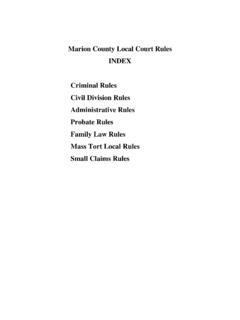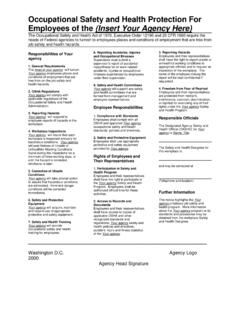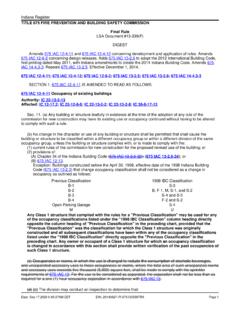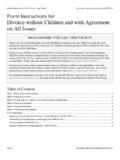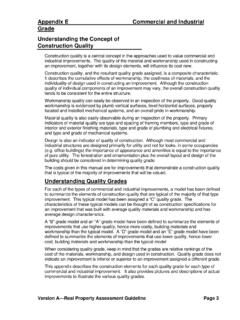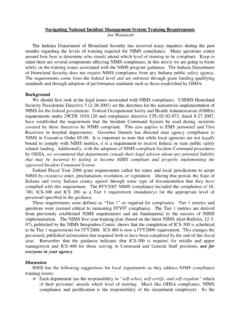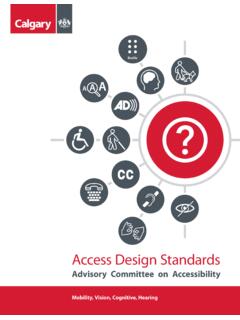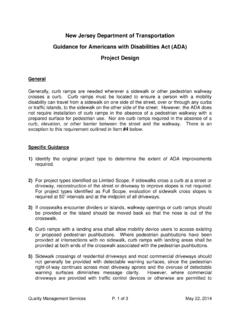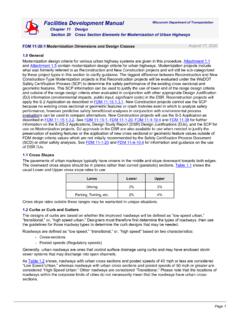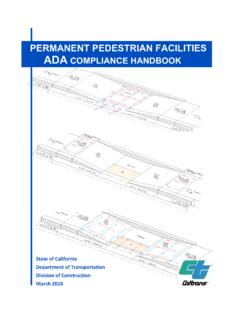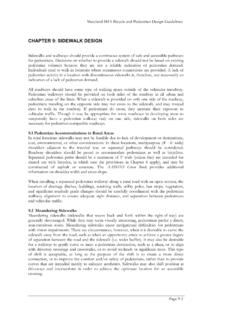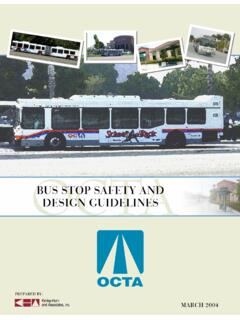Transcription of SECTION 22 –ADA COMPLIANCE FOR SIDEWALK, CURB …
1 ADA COMPLIANCE FOR SIDEWALK, curb RAMPS GIFE BLENDED TRANSITIONS, AND PEDESTRIAN FACILITIES SECTION 22 Rev. 03-01-22 22-1 SECTION 22 ADA COMPLIANCE FOR SIDEWALK, curb RAMPS, BLENDED TRANSITIONS, AND PEDESTRIAN FACILITIES SIDEWALKS AND curb RAMPS (Rev. 03-01-22) Regulations When constructing pedestrian facilities (sidewalk, trail, non-vehicular use facility), the requirements of the Americans with Disabilities Act (ADA) must be met regardless of the contract s funding source. Exceptions to these requirements require a determination of technical infeasibility, issued by the Highway Design and Technical Support Division in conjunction with the Department s Title VI Program and FHWA.
2 The intent is that technical infeasibility is determined prior to construction. If the plans do not accurately reflect the field conditions encountered, particularly when curb ramps are involved, the PEMS should discuss the situations with the AE and the designer to examine alternative solutions. Doing the best you can is not sufficient for ADA COMPLIANCE . The Department s ADA Technical Advisory Committee, TAC, can provide technical assistance During the contract, if an alternative that meets the ADA requirements cannot be found, the PEMS should have the designer document the alternatives considered and request a determination of technical infeasibility from the TAC.
3 The Indiana Design Manual, IDM, describes this process. Work should not continue until a determination has been made. Indiana Design Manual IDM Chapter 51 contains information on ADA, curb ramp , sidewalk, and pedestrian pushbutton requirements. IDM Chapter 17 contains information on curb ramp quantities. Note: Effective with September 2016 lettings, curb ramps are no longer paid for by a type. Designers should be detailing all curb ramps on contract s construction plans. INDOT Standard Specifications 604 Sidewalks, curb Ramps, Steps, and Handrails 805 Traffic Signals Detectable Warning Surfaces.
4 INDOT Standard Drawings 604-SWCR Sidewalk curb Ramps 604-SWDK Sidewalk and Sidewalk Transitions 805-PBBA Pedestrian Pushbutton Assembly. ADAAG vs. PROWAG The 2010 ADA Standards for Accessible Design (2010 Standards) is the current standard for providing facilities that are readily accessible and usable by persons with disabilities. However, the guidelines were developed primarily for buildings and facilities outside the ADA COMPLIANCE FOR SIDEWALK, curb RAMPS GIFE BLENDED TRANSITIONS, AND PEDESTRIAN FACILITIES SECTION 22 Rev.
5 03-01-22 22-2 right of way. Pedestrian facilities within the public right of way contain elements to which the 2010 Standards cannot be readily applied. For this reason, the Access Board proposed guidelines specifically for pedestrian facilities in the public right of way denoted as the Public Rights-of-Way Accessibility Guidelines, PROWAG. These guidelines are recommended as best practice by FHWA and are currently being evaluated as part of the federal rulemaking process. Once adopted as a regulation, with or without modifications, the guidelines will be mandatory.
6 The PROWAG was used to develop the Department s ADA transition plan and should be used as the basis for identifying the required curb ramp , landing (turning space), and sidewalk dimensions and slopes (running slopes and transverse slopes). Changes from ADAAG to the PROWAG Very little has changed from the Americans with Disabilities Act Accessibility Guidance, ADAAG, to the PROWAG. The items listed below represent notable differences. 1. The minimum clear width of a curb ramp , turning space, or sidewalk, is 4 feet.
7 A 3-ft pinch point is not acceptable. For sidewalks where the width is less than 5 ft, a 5 ft by 5 ft passing space is required every 200 ft. 2. The grade (running slope) of the sidewalk shall not exceed the adjacent roadway profile grade. 3. A curb ramp running slope of 10% for a 6-in. rise is not acceptable. 4. A sidewalk adjacent to a roadway does not require a landing or handrail, regardless of the roadway grade. 5. Detectable warning elements must extend the full width of the ramp . Where forming is required, a 2-in.
8 Maximum border width may be provided. Only the clarification where a border is necessary is new. Changes from previous Department practice Much has changed from previous Department practice. The items listed below represent notable differences. 1. Designers have been directed to fully detail curb ramps on contract construction plans. Simply calling out a ramp by type, Type A, is not acceptable. Spot elevations, widths, and slopes should be shown or tabulated. 2. There is no construction tolerance for cross slope.
9 The maximum cross slope is The PROWAG contains exceptions to cross slope requirements for ramps and turning spaces when matching the grade of the adjacent roadway. Designers have been directed to use no more than as a design value. The IDM now states this explicitly. A 2-ft level ADA COMPLIANCE FOR SIDEWALK, curb RAMPS GIFE BLENDED TRANSITIONS, AND PEDESTRIAN FACILITIES SECTION 22 Rev. 03-01-22 22-3 is also identified for checking COMPLIANCE . Note: A 2-ft level is not required by PROWAG but was included so that the expectation was clear.
10 Forms should be checked prior to pour to ensure maximum slopes are not exceeded and minimum dimensions are met. 3. There is no construction tolerance for running slope. The maximum ramp running slope is Designers have been directed to use no more than as a design value. The IDM now states this explicitly. Note: A 2-ft level is not required by PROWAG but was included so that the expectation was clear. Forms should be checked prior to pour to ensure maximum slopes are not exceeded and minimum dimensions are met.

